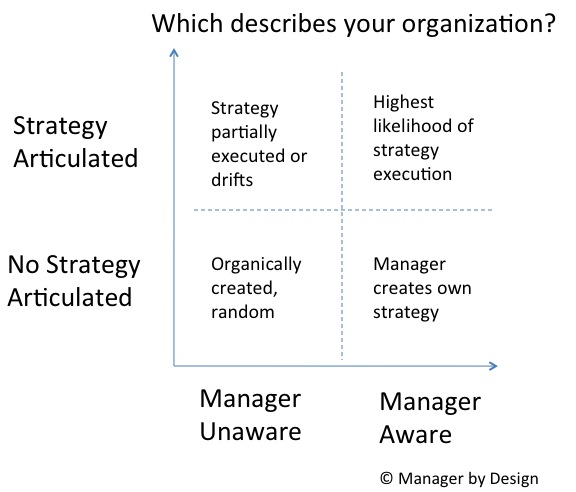Do your managers know the strategy of your organization?
Most organizations, both at the highest level and the departmental level, are supposed to have a strategy. And the managers of these organization are expected to execute that strategy. Seems simple enough, but let’s test these assumptions.
Think about your organization. What is the overall strategy? Can you articulate it from memory? Can you look it up somewhere? What activities are you doing in your department that support the strategy? Do you know where the strategy comes from?
Now think about your department and the managers in it. Do they know the organization’s overall strategy? Can they articulate it from memory or look it up somewhere? Do they know where it comes from? And. . . do they have a strategy articulated for how they execute the larger strategy?
Let’s take a look at which quadrant your organization or department may be in:
In this view, I’ve placed four general possibilities in the grid. On the Y-axis, we have the scale of whether the overall organization has a clearly defined and articulated strategy. The lower on the axis, the less the strategy is articulated and the more it is assumed to be implied, or, perhaps, completely lacking. On the X-axis, you have manager awareness of the strategy. Sure it’s important to have a strategy, but how aware are your managers of it? The further you go to the right on the X-axis, the more the manager is able to articulate and interpret the strategy.
According to the Manager by Design management/leadership model, managers are generally in charge of strategy execution, so this would seem to be an important thing to examine!
Given these four general quadrants, we can see that there are four possibilities for “strategy execution” based on the state of your organization’s strategy process (or lack thereof). Let’s take a look at these and consider which best describes your organization.
Lower Left: No Strategy/Manager Unaware
Basically, your organization has no strategy. The manager is unaware that there is no strategy. So, in absence of a strategy, a strategy will emerge and organically develop. The accidental, organic strategy may even emerge to be a strong strategy, and be interpreted as a defined and desirable strategy later on. But in the meantime it is purely by chance what strategy will emerge, where it will come from, and how strong or effective it will be. For many organizations, this may actually be the intended strategy, but it is certainly a high-risk one and one that is difficult to manage. If it is a large organization, then you are going to have high variance in results and execution, and anyone who uses the word “alignment” will most likely be scoffed at.
Lower Right: No Strategy/Manager Aware
In this scenario, the manager is aware that there is limited or no direction on what the overall strategy is. This gives the manager leeway to create her own strategy! Then the manager can then execute that strategy. If the manager is good at creating strategy, then you may get lucky and have some great results. However, if you have lots of managers, then you’ll get some wildly variant results. Expect pockets of greatness, and huge chasms of misery.
Upper Left: Strategy Articulated/Manager Unaware
Many organizations work really, really hard to develop a strategy. Then they throw it over the fence to the different departments, expecting it to stick somehow. So the strategy may be well thought out, but it goes nowhere. Certain elements of the strategy may seep through, as it could be expressed in various resource allocation decisions, but without full internalization of the managers, it is going to be either ignored or interpreted poorly. The strategy execution will look much different than what the strategists envisioned. Doing strategy is hard, but not having it understood by the strategy executors verges on making it pointless.
Upper Right: Strategy Articulated/Manager Aware
If your organization is serious about having a strategy, great! If the managers are able to articulate what that strategy is, then even better! At that point, you’re also increasing the chances that the line employees can also articulate the strategy. In this scenario, you are the most likely to see the organization’s strategy executed, or, if it doesn’t pan out like the strategy believed it would, you’ve at least removed one variable – manager awareness – that hurt the execution or the quality of the strategy.
So for those organizations that have a strategy that they want executed, a crucial element is the design in which managers learn, articulate, and express the strategy. If your organization is doing well with the more organic notion of strategy (lower left quadrant), be aware that lack of strategy is your strategy, and take your chances. You can get lucky and get good results, but at least keep a look out for when things aren’t going well, because you can’t assume that they always will go well.
In my upcoming articles, I’ll discuss how management design can help organizations bridge the gap between strategy and strategy execution.
Related articles:
A model to show the difference between managing and leading
How do managers learn strategy?
Management Design: The designs we have now – Manager knows and supports only one possible strategy
Management Design: The Designs we have now: Part time strategist, part time manager
Current management design: The one with the ideas becomes the manager
Management Design: The Designs we have now: The paths to management and leadership
Management Design: An alternative path to management and leadership: Loop in and out
